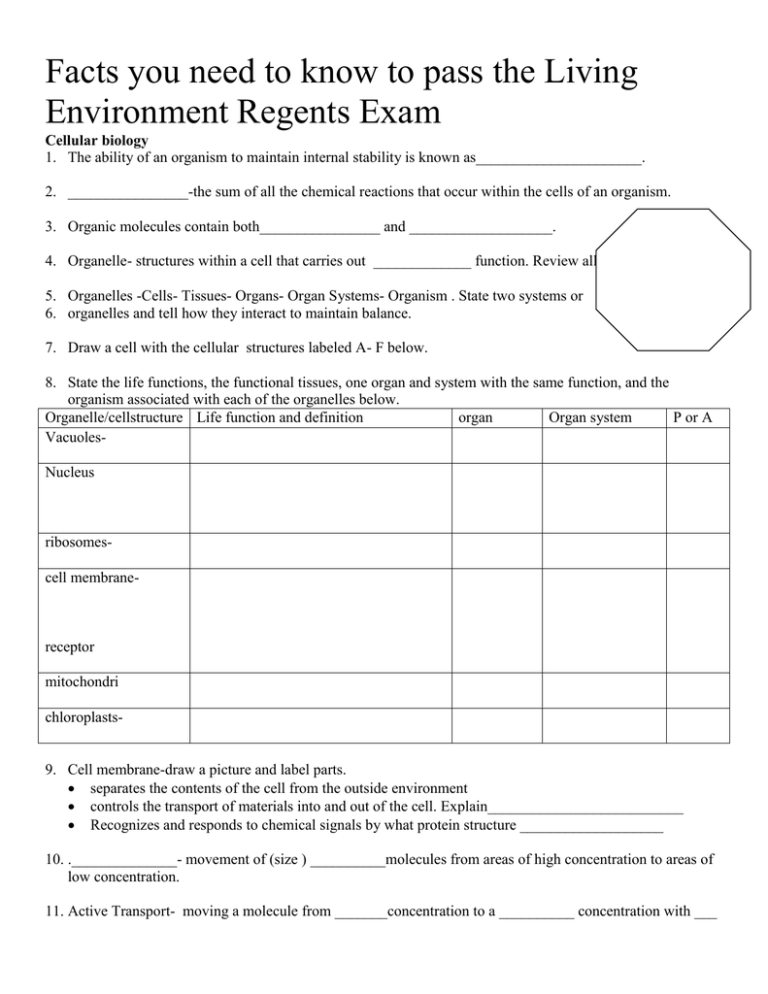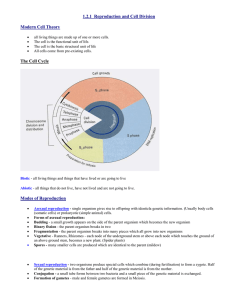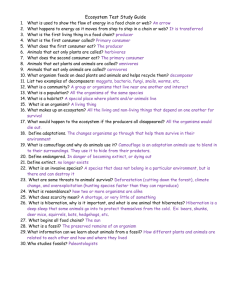Facts you need to know to pass the Living
advertisement

Facts you need to know to pass the Living Environment Regents Exam Cellular biology 1. The ability of an organism to maintain internal stability is known as______________________. 2. ________________-the sum of all the chemical reactions that occur within the cells of an organism. 3. Organic molecules contain both________________ and ___________________. 4. Organelle- structures within a cell that carries out _____________ function. Review all. 5. Organelles -Cells- Tissues- Organs- Organ Systems- Organism . State two systems or 6. organelles and tell how they interact to maintain balance. 7. Draw a cell with the cellular structures labeled A- F below. 8. State the life functions, the functional tissues, one organ and system with the same function, and the organism associated with each of the organelles below. Organelle/cellstructure Life function and definition organ Organ system P or A VacuolesNucleus ribosomescell membrane- receptor mitochondri chloroplasts- 9. Cell membrane-draw a picture and label parts. separates the contents of the cell from the outside environment controls the transport of materials into and out of the cell. Explain__________________________ Recognizes and responds to chemical signals by what protein structure ___________________ 10. .______________- movement of (size ) __________molecules from areas of high concentration to areas of low concentration. 11. Active Transport- moving a molecule from _______concentration to a __________ concentration with ___ 12. ___________-- breaking large molecules down into smaller molecules where they ___________ into blood. Proteins are broken down into ___________ _________. Starches are broken down into ____________ ___________. Disaccharides are broken down to ___________________________. 13. Coordination and control of an organism is ______________________ 14. Chemicals produced in the endocrine glands_(_______________) and chemicals produced by nerve cells are primarily responsible for communication between cells. 15. _________________- uses oxygen to oxidize nutrients to produces the more usable energy of _______ 16. _________________ involves the movement of materials inside the cell __________________the movement between parts of a multicellular organism make up the life function of _______________. 17. _______________ the removal of all metabolic waste produced by the cells of the body. 18. _________________ and ____________________systems coordinate and control of many activities. 19. Failure to maintain homeostasis can result in _______________ or _______________. 20. Photosynthesis- converts ____________________________ to ______________________ 21. Where is photosynthesis carried out?_____________ 22. Fermentation - Releasing (how much)_____________energy without ______________ 23. Fermentation occurs occurs in the _______________ and ____________ and produces _________. 24. _____________ -special proteins that affect the rate of chemical reactions. 25. ____________ any substance that can affect the rate of a chemical reaction without itself being changed or used up during the reaction. Below is a diagram of the lock and key model of enzyme specificity label it using words in box Substrate, Protein/ase, Enzyme, Maltose/ase, Active site, lipid/ase 26. Enzyme reaction rates are affected by what 3 factors? _____________________<______________________, __________________________________ 27. . Name three systems involved in Dynamic Equilibrium- steady state- homeostasis ________ ___________________________, __________________________,________________________ Positive feedback- a change prompts a response to a greater change and a greater response a. example- more substrate molecules after eating more digestion . b. nervous Negative feedback-more common; secondary control system maintains equilibrium a. example- immune b. example endocrine 28. When glucose levels are above normal the pancreas secretes ____________. This hormone prompts glucose to move from the blood into body cells, resulting in a lower glucose level in the blood. Another hormone secreted by the pancreas works in the opposite way. When the glucose level in the blood is too low, this hormone prompts the release of glucose stored in the ___________. 25.___________ is any condition that prevents the body from working as it should. 26.___________ certain genetic mutations in a cell can result in uncontrolled cell division. 27.____________system is the body's primary defense against disease-causing pathogens. 28._____________- a molecule found on the outer surfaces if cells that the immune system recognizes as either part of the body or an outside invader. 29._____________ proteins that either attack the invaders or mark them for killing. 30.____________ are made using weakened, killed or parts of pathogens. Produces antibodies 31.______________- is the passing of genetic information from one generation to the next through reproduction. 32.The hereditary information _________ is organized in the form of genes located in the _____________- of each cell. 33.Differences between asexual and sexual reproduction Asexual reproduction Sexual reproduction 34.Identical genetic copies are known as _________________. 35.Draw and label a nucleotide . 37.DNA 2 functions _______________________ and ___________________ ___________________. 38. DIFFERENCES DNA RNA Function Shape Bases Location 39.The sequence of amino acids.and shape of the protein is determined by the sequence of__________ 38.Any alteration of the DNA sequence is a ________________, which changes the normal message carried by the gene. 39. Characteristic 2 causes Gene mutation Chromosome mutation 2 Diseases 2 diagnosis techniques Cures 40.An organism's and cells environment can affect the way that some genes are expressed. 2 Examples41.___________ _____________-- is a technology that humans use to alter the genetic instructions in organisms. This results in ______________________ ________________. 42. Give 2 problems and 2 positive outcomes for the use of this technology. 43.__________ __________- a process that produces domestic animals and new varieties of plants with traits that are desirable. 44.Gene splicingexample: moving a human insulin-producing gene into a bacterial cell, the bacterium, and all of its offspring- will produce human insulin. This provides a way to produce large quantities of a hormone at low cost. 45._________ is a group of closely related organisms that share certain characteristics and can produce new individuals through reproduction. 46. Differences between mitosis and meiosis Mitotic division function Cell division # functioning cells_______ Genetic makeup_____________ Takes place Importance Meiotic division Male__________ female_______ 47.Gametes unite to form a _______________ during ___________________. 48.If the gametes each have 23 chromosomes , then what does their zygote have?_______________ 49._____________________- the process that transforms developing cells into specialized cells with different structures and functions takes place in the ____________________ in mammals. 50.Reproduction female- internal fertilization ovaries, progesterone, estrogen, uterus, placenta, egg fallopian t Characteristic Gamete Pathway to gamete /function 1 2 3 4 Hormones Male Female Menstrual cycle Follicle Ovulation Corpus Leuteum Menstruation Type of fertilization /development 52.Reproductive technology In vitro-fertilization 53.____________-the process by which organisms have changed overtimesimple,single-celled: complex-single-celled : complex, multicellular 54.Geologic time is based on the ______________ __________. 55.Natural selection overproduction struggle for survival Variation Adaptation 59.Any trait that helps an organism survive and reproduce under a given set of environmental conditions is said to have ____________ __________. 60.The failure to adapt to a changing environment may result in the ___________________of a species. 62. Give an example of how natural selection takes place with development of resistance. 63._______________- is the study of how organisms interact with the living and nonliving things. 64.Give three criteria for an ecosystem______________________________________, ______________________________________________, __________________________________ 65._____________ factors, plants, animals 65.Abiotic factors-_________________________________________ such as ________________66 A species home____________ 67.____________________-- all the organisms of a species that live in the same area. 68.___________________ all the different populations in an area. 69.______________________all of earth's ecosystems 70.___________________- is the struggle for resources among organisms sharing the same niche. 71.Factors in the environment that limit the size of populations are known as __________ _________. examples: 72.The number or organisms of any species that an ecosystem can support is referred to as its ___________ _________________. 73.Define 3 forms of symbiosis and give examples of these nutritional relationships. Mutalism Parasitism Commensilism 73.____________which kill and eat other organisms and _________ which are killed for food. 74.____________ the role that each species plays in an ecosystem. 75.autotrophs76.heterotrophs77.herbivorescarnivoresomnivores consumers decomposers scavengersparasites 78.Difference between a food chain and a food web 79.What is the main source of energy on the earth?____________ Flow of energy- energy is moves through a food web in the environment, It does NOT RECYCLE. IT IS LOST at each pyramid level. 80. On an energy pyramid where is the most amount of energy located?___________________ 81.Material cycles in an ecosystem Cycle Eco problem Water carbon nitrogen pathway Contributing biological processes 82.________________ is a measurement of the degree to which species vary within an ecosystem. 83.As biodiversity increases, _____________ of an ecosystem increases. 84 Examples of man’s affect on biodiversity . .HUMAN ACTIVITIES AND THE LOSS OF DIVERSITY 1.Direct harvestingSolution: 2.land overuseSolution: 3.habitat destructionSolution 4.deforestationSolution: 5.imported species (invasive species or exotic species) Solution: 85.ecological succession86.Both ___________________ and ____________________contribute to the final state of equilibrium of species in the area undergoing change. 87.renewable resources88.nonrenewable resources87.Preserving our resources from exploitation and depletion. Give 4 techniques : 88.______________ a harmful change in the chemical makeup of the air, water, or soil. Impact of technology and industrialization 2.industrialization- increases pollution of air and water- uses more energy, water and fossil and nuclear fuels. 3.Water pollution-from sewage, wastes from homes and factories and animal wastes 4.Toxic wastes- DDT 5.Thermal pollution6.air pollution- burning fossil fuels 7.acid rain8.smog- 9.global warming10.ozone depletion89.Natural processes in Ecosystems 1.maintaining atmospheric quality 2.soil formationLab skills 4 criteria for validity : accurate measurements, sufficient trials, repeat experiment, experimental controls Experimental design: title, problem, hypothesis, materials, procedures, data tables, control, independent variable and the levels of independent variable, dependant variable. Experimental techniques, and evaluation of lab activities in enzyme action, cell observation, heart rate, connections to other systems, diffusion, genetics, evolution, plant metabolism, Science Research: apply scientific information to current problems, citation of information in literature/articles, make conclusions on data, data tables and graphs.








